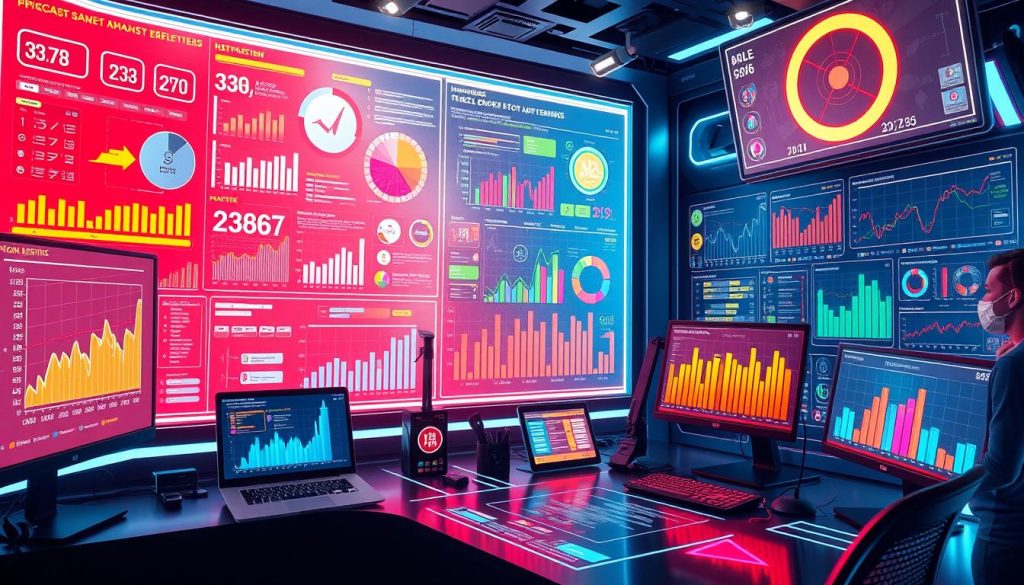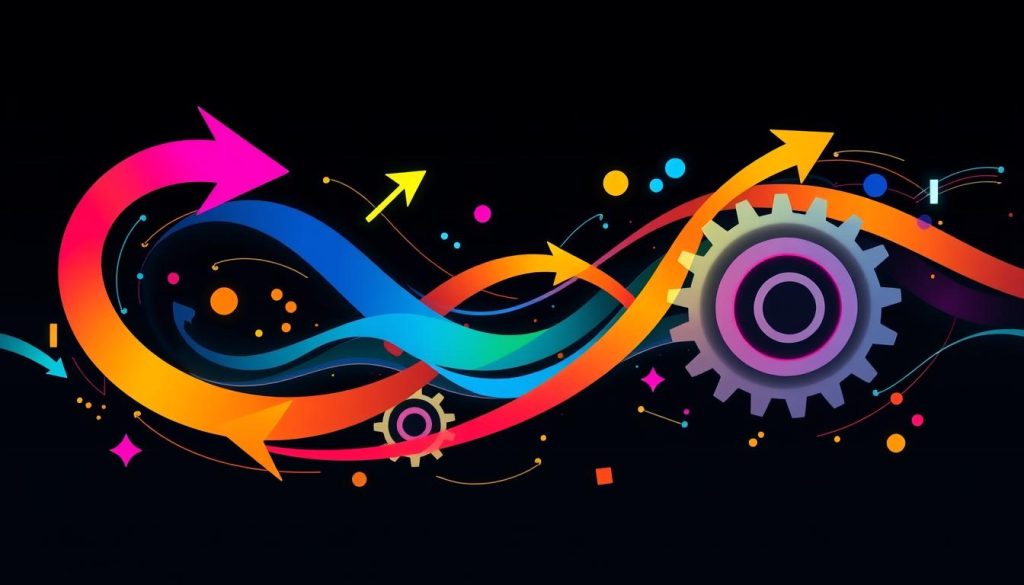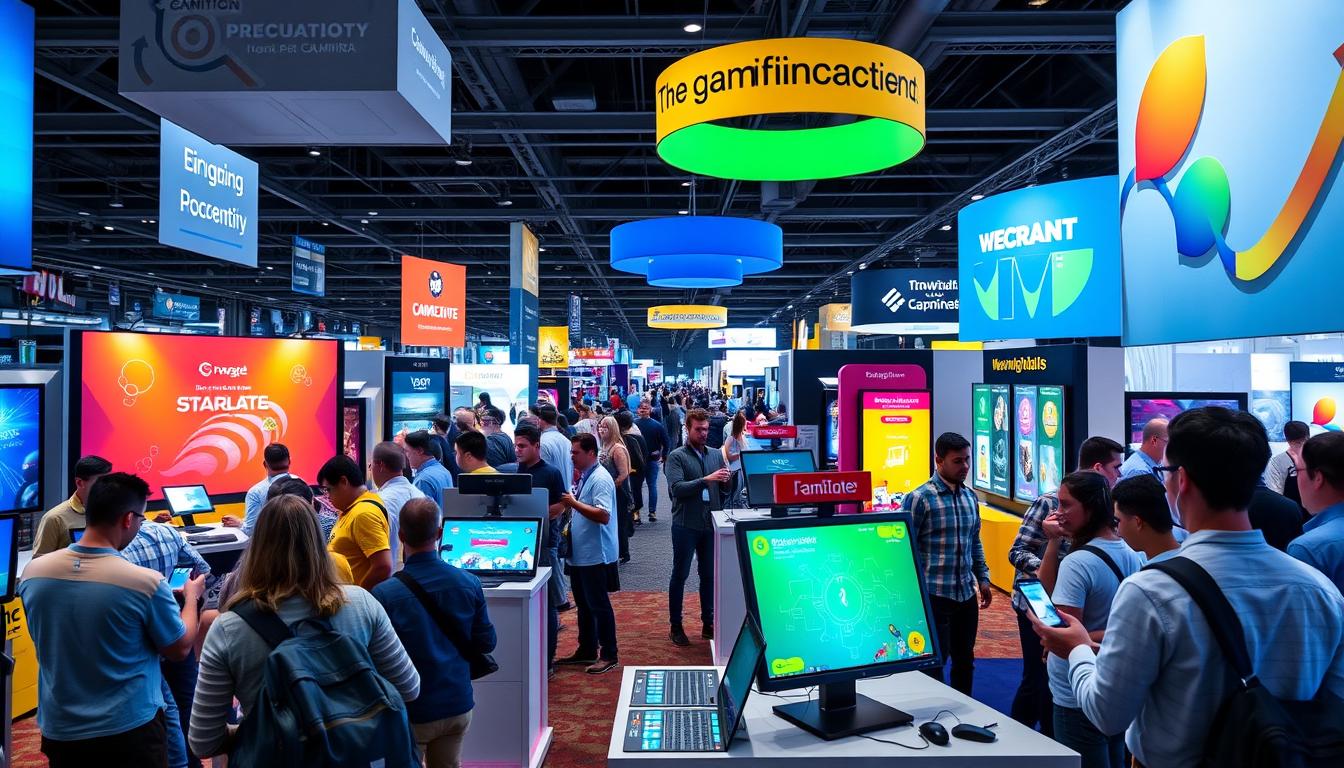Gamification is changing the way we engage at tradeshows. This fun approach uses game elements to boost visitor interest and participation. The science behind gamification at tradeshows taps into our basic desires for rewards and achievement.
By applying gamification psychology, exhibitors create engaging tradeshow activities that captivate attendees. These strategies leverage our natural inclination towards play and competition, making booth visits more memorable and effective.
The science of gamification explores how game-like features can drive behavior. At tradeshows, this translates to increased booth traffic, longer visitor interactions, and improved information retention. By understanding the psychological principles at work, exhibitors can design experiences that resonate with attendees on a deeper level.
Key Takeaways
- Gamification uses game elements to boost engagement
- It taps into psychological needs for rewards and achievement
- Engaging activities make tradeshow experiences memorable
- Game-like features can increase booth traffic and interaction time
- Understanding gamification psychology helps design effective experiences
Fundamentals of Gamification Psychology
Gamification psychology forms the backbone of creating engaging visitor experiences. By understanding the science behind human motivation, we can design captivating tradeshow environments that leave lasting impressions.
Dopamine Release and Reward Systems
The brain’s reward system plays a crucial role in gamification. When visitors complete tasks or achieve goals, their brains release dopamine, creating feelings of pleasure and satisfaction. This neurochemical response drives continued engagement and enhances visitor experience enhancement.
Intrinsic vs. Extrinsic Motivation
Gamification leverages both intrinsic and extrinsic motivation. Intrinsic motivation comes from within, driven by personal interest or enjoyment. Extrinsic motivation relies on external rewards or recognition. Balancing these two types of motivation is key to creating compelling gamified experiences that resonate with diverse.
The Role of Competence and Mastery
Feeling competent and achieving mastery are powerful motivators in gamification psychology. As visitors progress through challenges, their sense of accomplishment grows, fueling further engagement. This principle can be applied to create immersive tradeshow experiences that keep attendees coming back for more.
| Psychological Element | Impact on Visitor Experience | Implementation in Tradeshows |
|---|---|---|
| Dopamine Release | Increased engagement and satisfaction | Interactive games with immediate feedback |
| Intrinsic Motivation | Long-term interest and loyalty | Personalized challenges aligned with visitor interests |
| Extrinsic Motivation | Short-term excitement and participation | Leaderboards and tangible rewards |
| Competence and Mastery | Increased confidence and repeated engagement | Progressive skill-based activities |
By incorporating these fundamental principles of gamification psychology, tradeshow organizers can create unforgettable experiences that drive engagement and boost conversions.
The Science Behind Gamification at Tradeshows
Tradeshows are evolving. Gone are the days of static displays and passive attendees. Today’s successful exhibitions leverage the power of gamification to create memorable experiences. This scientific approach taps into our brain’s reward systems, making engaging tradeshow activities irresistible to participants.
Interactive booth design plays a crucial role in this transformation. By incorporating game elements, exhibitors can:
- Boost attendee engagement
- Increase brand recall
- Gather valuable lead data
The science is clear: gamification works because it triggers dopamine release in our brains. This feel-good chemical reinforces behaviors, making us more likely to participate and remember the experience.
“Gamification at tradeshows isn’t just fun and games. It’s a powerful tool backed by neuroscience and psychology.”
Successful tradeshow gamification strategies often include:
- Virtual reality challenges
- Scavenger hunts across multiple booths
- Interactive quizzes with real-time leaderboards
These engaging tradeshow activities not only draw crowds but also provide valuable data on attendee preferences and behaviors. This information helps exhibitors refine their strategies for future events, creating a cycle of continuous improvement.
Core Game Mechanics and Their Psychological Impact
Game mechanics play a crucial role in creating engaging experiences at tradeshows. By understanding the psychology behind these mechanics, exhibitors can design more effective booths and interactions. Let’s explore how key elements like points, badges, and leaderboards can drive visitor engagement and boost tradeshow success.
Points, Badges, and Leaderboards
Points systems tap into our innate desire for achievement. At tradeshows, visitors can earn points for various activities, from attending presentations to trying product demos. This motivational game mechanic encourages active participation and exploration of the event.
Badges serve as visual representations of accomplishments. They can be awarded for completing specific tasks or reaching milestones. These virtual trophies provide a sense of pride and progress, motivating visitors to engage more deeply with exhibitors.
Leaderboards introduce a competitive element, displaying top performers. This can spark friendly rivalry among attendees, driving them to interact more with exhibits to climb the rankings.
Progress Bars and Achievement Systems
Progress bars visually track advancement towards goals. In a tradeshow context, they can show how close visitors are to earning rewards or completing event challenges. This clear feedback loop keeps attendees engaged and focused on their objectives.
Achievement systems offer a structured way to recognize visitor accomplishments. By setting up tiered goals, exhibitors can guide attendees through a series of meaningful interactions, enhancing their overall experience.
Social Competition and Collaboration
Incorporating social elements into tradeshow games can amplify engagement. Team-based challenges encourage collaboration, while individual competitions can drive personal achievement. These social dynamics create memorable experiences and foster connections among attendees.
| Game Mechanic | Psychological Impact | Tradeshow Application |
|---|---|---|
| Points | Sense of achievement | Reward booth visits and interactions |
| Badges | Pride in accomplishments | Recognize product knowledge or demo completion |
| Leaderboards | Competitive drive | Display top engaged visitors |
| Progress Bars | Goal visualization | Track event challenge completion |
| Social Collaboration | Connection and teamwork | Group scavenger hunts or quizzes |
By leveraging these core game mechanics, exhibitors can create immersive experiences that resonate with visitors. Tradeshow visitor analytics can help fine-tune these strategies, ensuring maximum engagement and ROI for both exhibitors and attendees.
Neuroscience of Engagement in Gamified Experiences
The science behind gamification at tradeshows goes deep into our brains. Gamified experiences tap into the brain’s reward system, triggering a rush of feel-good chemicals. This neurological response hooks visitors and keeps them engaged with your brand.
When tradeshow attendees interact with gamified elements, their brains release dopamine. This neurotransmitter is linked to pleasure and motivation. It’s the same chemical that makes us feel good when we accomplish a task or win a game. By designing gamified experiences that trigger dopamine release, exhibitors can create powerful visitor experience enhancement.
Brain scans show increased activity in the prefrontal cortex during gamified tasks. This area is responsible for decision-making and problem-solving. Engaging this part of the brain can lead to deeper brand connections and increased memory retention of your product information.
“Gamification activates the brain’s reward pathways, creating a positive association with your brand that lasts long after the tradeshow ends.”
Understanding the neuroscience behind engagement allows exhibitors to craft more effective gamification strategies. By leveraging these brain-based insights, companies can create memorable experiences that stand out on the tradeshow floor. This approach not only attracts more visitors but also improves information recall and brand loyalty.
Implementing these neuroscience-backed techniques requires careful planning. Consider creating drip campaigns to maintain engagement with leads long after the event. This strategy helps reinforce the positive neural pathways formed during the initial gamified experience.
By tapping into the brain’s natural reward systems, exhibitors can create powerful, lasting impressions. This scientific approach to gamification at tradeshows sets the stage for increased brand recognition and customer loyalty.
Behavioral Economics in Gamification Design
Gamification at tradeshows is evolving with insights from behavioral economics. This field helps create data-driven gamification strategies that tap into human psychology for better engagement.
Choice Architecture and Decision Making
Smart design of choices can guide visitor behavior at tradeshows. By presenting options strategically, exhibitors can nudge attendees towards desired actions. This could mean placing high-value prizes at eye level or using color psychology to highlight key areas.
Loss Aversion and Risk Assessment
People fear losses more than they value gains. Tradeshow games can use this by offering limited-time offers or exclusive access. For example, a countdown timer on a prize wheel creates urgency and boosts participation in engaging tradeshow activities.
Temporal Discounting in Rewards
Immediate rewards often trump future benefits in our minds. Successful gamification strategies offer a mix of instant gratification and long-term incentives. A points system with both quick wins and grand prizes can keep visitors hooked throughout the event.
| Behavioral Principle | Gamification Application | Tradeshow Example |
|---|---|---|
| Choice Architecture | Strategic option placement | Eye-level display of top prizes |
| Loss Aversion | Time-limited offers | Countdown timer on prize wheel |
| Temporal Discounting | Balanced reward system | Points for instant and grand prizes |
By applying these principles, businesses can create more effective and engaging tradeshow experiences. Leveraging tools like GoHighLevel can further enhance these strategies, providing valuable insights and automation capabilities for optimal results.
Data-Driven Approaches to Gamification Strategy
Gamification at tradeshows has evolved beyond simple point systems. Today, tradeshow organizers use sophisticated data-driven gamification strategies to boost engagement and ROI. These methods rely on advanced tradeshow visitor analytics to create personalized, compelling experiences.

Analytics and User Behavior Tracking
Modern tradeshow platforms collect vast amounts of data on visitor behavior. This includes booth visits, time spent at exhibits, and interactions with digital content. By analyzing this data, organizers can identify trends and tailor their gamification elements for maximum impact.
Personalization Algorithms
Personalization is key to effective gamification. Advanced algorithms process visitor data to create unique experiences for each attendee. This might include customized challenges, rewards, or content recommendations based on individual interests and behavior patterns.
Performance Metrics and KPIs
To measure the success of gamification efforts, tradeshow organizers track specific key performance indicators (KPIs). These may include:
- Engagement rate
- Booth traffic increase
- Lead quality improvement
- Post-event survey scores
By focusing on these metrics, organizers can continually refine their data-driven gamification strategies for future events. This approach ensures that gamification elements not only entertain but also drive measurable business outcomes.
Creating Immersive Interactive Environments
Immersive tradeshow environments captivate visitors and leave lasting impressions. By blending cutting-edge technology with interactive booth design, exhibitors can create unforgettable experiences that engage attendees on multiple levels.
Virtual reality (VR) and augmented reality (AR) are game-changers in interactive booth design. These technologies transport visitors to new worlds, allowing them to explore products and services in ways never before possible. Imagine stepping into a virtual factory tour or manipulating 3D product models with hand gestures – the possibilities are endless.
Gamification elements enhance immersion and boost engagement. Interactive touchscreens, motion-sensing displays, and customized digital experiences keep visitors entertained while educating them about your offerings. These elements tap into our natural desire for exploration and achievement, creating memorable moments that resonate long after the event ends.
“Immersive environments aren’t just about flashy tech. They’re about creating emotional connections and lasting memories.”
The psychological impact of immersive tradeshow environments is profound. By engaging multiple senses, these spaces enhance information retention and brand recall. Visitors are more likely to remember and act on experiences that evoke strong emotions or provide unique interactions.
When designing your next tradeshow booth, consider how you can create an immersive, interactive environment that tells your brand story in a compelling way. By doing so, you’ll stand out from the crowd and leave a lasting impression on potential customers.
Motivation Design and Player Psychology
Gamification psychology plays a crucial role in enhancing visitor experience at tradeshows. Understanding player types, engagement loops, and flow state theory can help create immersive experiences that captivate attendees.
Player Types and Personas
Different visitors have unique motivations and preferences. By identifying player types, we can tailor gamified experiences to suit diverse audiences. Here’s a breakdown of common player personas:
| Player Type | Characteristics | Preferred Activities |
|---|---|---|
| Achievers | Goal-oriented, competitive | Challenges, leaderboards |
| Explorers | Curious, knowledge-seeking | Quests, hidden content |
| Socializers | Community-focused, collaborative | Team challenges, networking games |
| Killers | Highly competitive, dominant | PvP contests, high-stakes challenges |
Engagement Loops
Engagement loops are key to sustaining visitor interest. These cycles of action, feedback, and motivation keep attendees engaged throughout the event. A well-designed loop might involve completing a task, earning points, and unlocking new challenges.

Flow State Theory
Flow state, a concept developed by psychologist Mihaly Csikszentmihalyi, describes a state of optimal experience where people are fully immersed in an activity. In tradeshow gamification, creating flow involves balancing challenge and skill levels to keep visitors engaged without overwhelming them.
By applying these principles of motivation design and player psychology, tradeshows can create engaging experiences that resonate with diverse attendees, enhancing overall visitor satisfaction and interaction.
Measuring Success in Gamified Systems
Evaluating the impact of gamification at tradeshows is crucial for refining strategies and maximizing returns. By focusing on key metrics, businesses can gain valuable insights into visitor engagement and behavior. Let’s explore how to measure success in gamified systems effectively.
Engagement Metrics
Tradeshow visitor analytics play a vital role in understanding attendee interactions. Track metrics like time spent at your booth, interactions with gamified elements, and social media shares. These data points help gauge the effectiveness of your gamification efforts and identify areas for improvement.
Behavioral Change Indicators
Look beyond surface-level engagement to spot meaningful behavioral shifts. Monitor changes in lead quality, follow-up requests, and post-event interactions. These indicators reveal how well your gamified experience influences long-term customer relationships and sales potential.
ROI Assessment Framework
Implementing data-driven gamification strategies requires a solid ROI assessment framework. Compare the costs of developing and running gamified elements against the value of leads generated, deals closed, and brand awareness gained. This approach helps justify investments and guides future decision-making for tradeshow participation.
FAQ
What is gamification in the context of tradeshows?
Gamification at tradeshows involves applying game-like elements and mechanics to non-game environments to enhance visitor engagement, motivation, and participation. It leverages psychological principles to create more interactive and enjoyable experiences for attendees.
How does gamification psychology work in tradeshow environments?
Gamification psychology in tradeshows works by tapping into fundamental human motivations and behaviors. It utilizes concepts like dopamine release, reward systems, and the balance between intrinsic and extrinsic motivation to create engaging activities that captivate visitors and encourage them to interact more deeply with exhibits and brands.
What are some examples of engaging tradeshow activities using gamification?
Engaging tradeshow activities using gamification can include interactive quizzes, scavenger hunts across the show floor, virtual reality experiences, badge-collecting challenges, leaderboard competitions, and progress-based rewards systems. These activities are designed to make the tradeshow experience more fun, memorable, and rewarding for visitors.
How can interactive booth design incorporate gamification elements?
Interactive booth design can incorporate gamification elements through touch-screen displays with game-like interfaces, augmented reality experiences, physical puzzles or challenges, digital leaderboards, and personalized visitor journeys based on collected data. The key is to create an immersive environment that encourages active participation and exploration.
What are some key motivational game mechanics used in tradeshow gamification?
Key motivational game mechanics used in tradeshow gamification include points systems, badges for achievements, leaderboards to foster competition, progress bars to show advancement, social collaboration challenges, and tiered reward structures. These mechanics tap into psychological drivers like the need for achievement, social recognition, and a sense of progress.
How can tradeshow visitor analytics be used to improve gamification strategies?
Tradeshow visitor analytics can be used to improve gamification strategies by providing insights into visitor behavior, preferences, and engagement patterns. This data can inform the design of more targeted and effective gamification elements, help personalize experiences, and allow for real-time adjustments to optimize engagement and achieve desired outcomes.
What is the role of neuroscience in designing gamified tradeshow experiences?
Neuroscience plays a crucial role in designing gamified tradeshow experiences by providing insights into how different game elements activate specific brain regions associated with pleasure, reward, and decision-making. This understanding helps in creating experiences that are not only engaging but also neurologically stimulating, leading to better memory formation and brand recall.
How does behavioral economics influence gamification design at tradeshows?
Behavioral economics influences gamification design at tradeshows by applying principles such as choice architecture, loss aversion, and temporal discounting. These concepts help in structuring gamified experiences that nudge visitors towards desired behaviors, create a sense of urgency or exclusivity, and optimize reward systems to maximize engagement and participation.
What are some key performance indicators (KPIs) for measuring the success of gamification at tradeshows?
Key performance indicators for measuring the success of gamification at tradeshows include engagement rates, time spent at booths, number of interactions per visitor, lead quality and quantity, social media mentions, badge or point accumulation rates, and post-show survey responses. These metrics help in assessing both the immediate impact and long-term effectiveness of gamification strategies.
How can tradeshows create immersive environments through gamification?
Tradeshows can create immersive environments through gamification by integrating technologies like virtual and augmented reality, designing cohesive themed experiences across the event, implementing storyline-driven challenges, and creating multi-sensory interactions. The goal is to transport visitors into a more engaging and memorable world that enhances their overall tradeshow experience.


